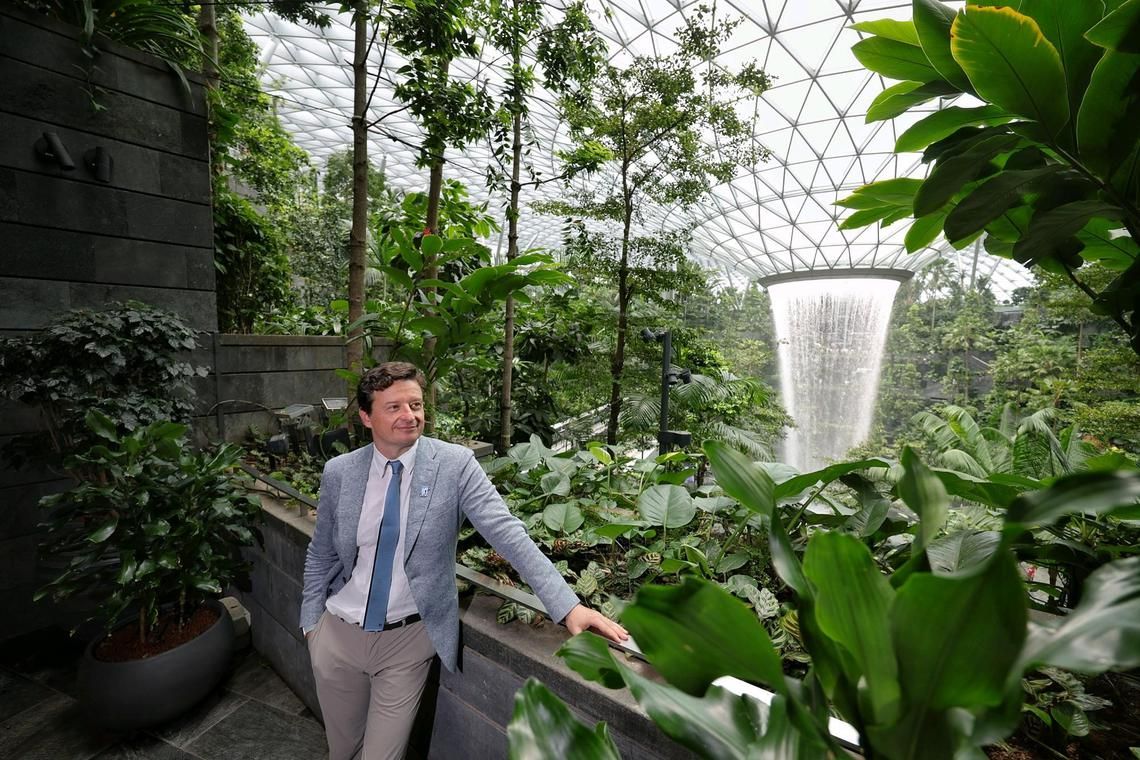SINGAPORE – Changi Airport has to start building Terminal 5 soon if it wants to remain competitive against leading airports in the Asia-Pacific region that are scaling up to meet forecasted demand, the regional chief of a global airport body has said.
Singapore “cannot waste more time if it wants to keep its position” as the world’s best, said Mr Stefano Baronci, director-general of Airports Council International (ACI) Asia-Pacific and Middle East.
He was speaking to reporters at Jewel Changi Airport on May 13 in an interview on the state of the aviation industry in the region.
Changi would have to maintain a high quality of service, and cooperate with the Government and other parties to promote inbound travel and expand airline connectivity, in order to keep T5 ahead of the competition, Mr Baronci, who is based in Bangkok, said.
ACI World, a global airport trade association, has five regional branches. Its Asia-Pacific and Middle East arm represents 133 airport members that operate 623 airports.
Construction on T5 is set to start in mid-May after delays due to the Covid-19 pandemic.
Looking at some of Singapore’s competition, Mr Baronci noted that Hong Kong International Airport (HKIA) is ahead of Singapore in terms of new airport infrastructure.
It has added a third runway, and is expanding its existing Terminal 2 that is slated to open in 2025. By the mid-2030s, HKIA aims to serve 120 million passengers annually, up from more than 70 million now.
In Bangkok, Suvarnabhumi International Airport officially opened a satellite terminal in March 2025, boosting its annual passenger capacity by 15 million to reach 60 million. It is also building a third runway and a new South Terminal, which will further boost capacity by 70 million passengers annually, to a total of 130 million.
Seoul’s Incheon International Airport completed an expansion in 2024 – including the construction of a fourth runway – that will allow it to handle over 100 million passengers annually.
This would see these airports join the ranks of mega airports, defined as those that can handle more than 100 million passengers a year.
According to ACI data from 2024, there are 10 cities with mega airports or mega airport systems – referring to cities with more than one airport. Of these, three are in Asia: Beijing, Tokyo and Shanghai.
The airports in Bangkok and Seoul handled around 93 million and 94 million passengers in 2024, respectively. The cities have two airports each: Don Mueang International Airport is the other international airport in Bangkok, while Seoul’s second airport is Gimpo International Airport.
Changi Airport handled 67.7 million passengers in 2024.
In 2024, Hong Kong International Airport handled 53.1 million passengers, while Suvarnabhumi International Airport handled approximately 62.2 million passengers.
In the same year, Incheon International Airport handled a record-breaking 70.5 million international passengers.
The opening of T5 in the mid-2030s will put Changi Airport in mega airport status, Mr Baronci said.
The new terminal will be able to handle up to 50 million passengers a year on top of Changi Airport’s current capacity of 90 million, raising the airport’s annual capacity to 140 million passengers.
Impact of tariffs on aviation unclear
Turning to the impact that US President Donald Trump’s tariffs or will have on the aviation sector, Mr Baronci said any effect will be felt by the air cargo sector first, which will “inevitably… be impacted by tariffs”.
Any impact on passenger traffic will be less clear, as “there are several factors that impact the behaviour of the passenger”, such as airfares.
On May 12, China and the US agreed to slash reciprocal tariffs on each other and to commit to trade talks – a move that has perked up markets and assuaged fears of a global economic slowdown.
A more immediate concern for the aviation sector than tariffs is geopolitics, which has a clear effect on aviation, Mr Baronci said, pointing to the Russia-Ukraine, Israel-Palestine, India-Pakistan conflicts.
In the case of India-Pakistan, the recent hostilities “(forced) airlines to choose the northern path or the southern one”, he said.
“What this means is that the duration of a flight is longer, that you have a higher congestion, and this translates into delays and into a higher cost.”
Apac the ‘epicentre’ of aviation
Mr Baronci said ACI expects future mega airports to come from Asia, due to factors such as the region having more megacities – those with more than 10 million people – as well as its macroeconomic development and population growth.
Of the current 39 megacities in the world, 25 are in Asia, including Tokyo, Delhi, Shanghai, Dhaka and Manila.
“The epicentre… of aviation is Asia,” Mr Baronci said.
About 30 airports in Asia-Pacific and the Middle East have committed US$240 billion (S$313.1 billion) in the next 10 years to 2023 to upgrade existing facilities and building new ones, according to ACI. “In this region, a new cycle of investment has started,” Mr Baronci said.
“An important message is that uncertainty should not be a reason for for retreat, but rather a call for building, for diversification and innovation.”
- Vanessa Paige Chelvan is a correspondent at The Straits Times. She writes about all things transport and pens the occasional commentary.
Join ST’s WhatsApp Channel and get the latest news and must-reads.

